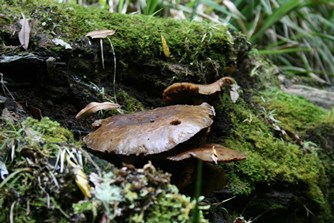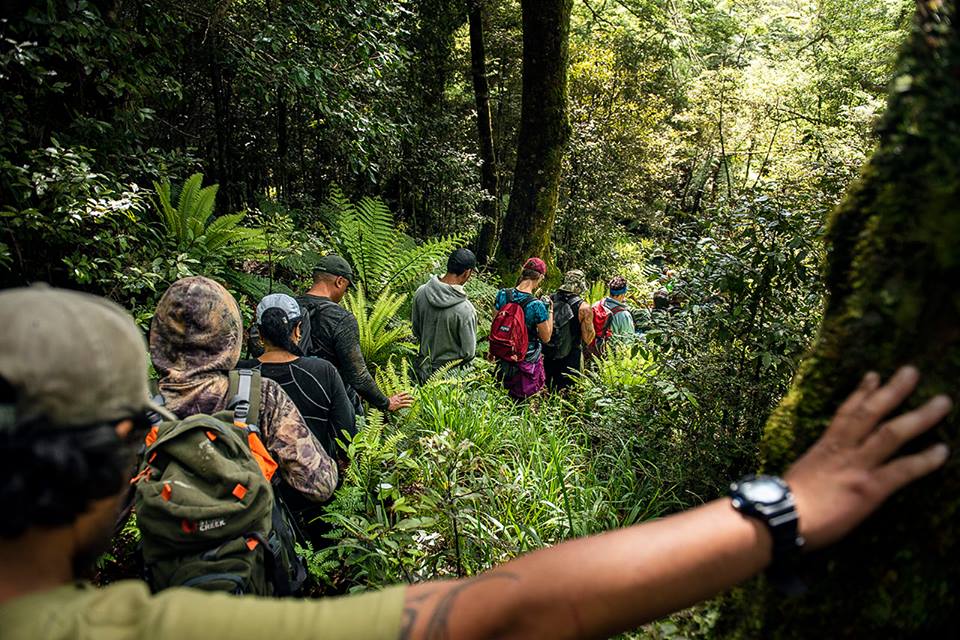
Projects
tuawhenua.biz
At any one time we have a number of projects across a range
of activities. Reports on some of these projects are available
below:
An indigenous community-based monitoring system for
assessing forest health in New Zealand 2016
Environmental & Pest Issues in Te Tuawhenua 2012
Podocarp Restoration in Te Tuawhenua 2012
Industry and People Development in the Tuawhenua 2013
For an independent evaluation of the Podocarp Restoration
Project see Ministry for Primary Industries
Beau Riini, Raniera Te Kurapa and Raymond Te Kurapa of Te Urewera hapu
tagging seedlings for transplanting in the podocarp restoration programme. This
podocarp restoration site is at Otekura on Apithana T2 block, which was planted
out in the winter of 2010.


Even in decay there is life. Here a tawa tree has died and rots, but feeds different
types of fungi. The harore is a revered food of our people that grows on rotting
tawa. This is some ofour work from the Matauranga Project
Te Whare o Rehua, Te Oranga o te Ngahere July 16-19 2019
The Tuawhenua Trust is pleased to announce we will be holding our third programme for Te Whare o Rehua Academy Te Oranga o te Whenua in July 2019. Overall Te Whare o Rehua Academy is designed to reconnect our younger people to the Ngahere, through a range of means including the transfer of Matauranga o Te Tuawhenua, Te Manawa o te Ika, about the ngahere and the whenua to the next generations.

This new two-part documentary gives a rare and insightful look into our unique relationship with Te Urewera as seen through Tuawhenua’s connection with the kererū. Te Kura Huna o Te Urewera (The Hidden Treasure of Te Urewera) speaks to the revival and intergenerational transfer of Tuawhenua kawa (protocols and etiquette), tikanga (procedures and guidelines) and mātauranga (traditional knowledge) as it relates to the kererū or New Zealand pigeon (Hemiphaga novaeseelandiae), which we recognise as a manu rangatira (chiefly bird species). Tuawhenua’s researcher Puke Timoti and Dr Phil Lyver of Manaaki Whenua-Landcare Research worked closely over several years with the Ruatāhuna community to explore Tuawhenua’s relationship with the kererū and Te Urewera. They interviewed more than 60 kaumātua and community members over that time.
“We were very privileged to gain access to those that lived and grew up in Te Urewera and then have them recount their knowledge and experiences of the kererū openly and freely,” says Puke Timoti. “Their traditional beliefs and practices are key to how they live their lives.”
Phil Lyver says the outcomes of the research project were two-fold. “We firstly wanted to support the inter-generational transfer of mātauranga relating to the kereru within the Ruatāhuna community. “We also advocate for reforms to New Zealand’s conservation policies and governance and legal mechanisms that better prioritise the type of connection that tangata whenua want with their environments, including the nurturing of both biological and cultural heritage.”
This research is vital to us better understanding how the transfer of mātauranga (knowledge), in this case of the kererū and te mita o Tūhoe (the Tūhoe language) and the ngahere, occurs in a modern context.
“We were very privileged to gain access to those that lived and grew up in Te Urewera and then have them recount their knowledge and experiences of the kererū openly and freely,” says Puke Timoti. “Their traditional beliefs and practices are key to how they live their lives.”
Phil Lyver says the outcomes of the research project were two-fold. “We firstly wanted to support the inter-generational transfer of mātauranga relating to the kereru within the Ruatāhuna community. “We also advocate for reforms to New Zealand’s conservation policies and governance and legal mechanisms that better prioritise the type of connection that tangata whenua want with their environments, including the nurturing of both biological and cultural heritage.”
This research is vital to us better understanding how the transfer of mātauranga (knowledge), in this case of the kererū and te mita o Tūhoe (the Tūhoe language) and the ngahere, occurs in a modern context.
Te Kura Huna o Te Urewera
Tuawhenua Forest Fund
The forests in our region are suffering under the impacts of introduced pests, even though from a distance our region looks like a healthy native forest. Our long term goal is to support and enhance our forest life to flourish into the future. But, we do not have the funds to support ongoing programmes for this purpose, and government funding is erratic and short-term without a long term focus.
Indeed, one of the reasons we started Manawa Honey was our intention to use this commercial enterprise to support development of our people and enhancement of our forests. With Covid and other factors impacting on Manawa Honey, these benefits have been slow to realise.
So, in 2022, we set up a through an initiative Matariki Ahunga Nui designed in turn to establish a capital fund – the Tuawhenua Forest Fund – with the purpose of enhancement of our forests.
Indeed, one of the reasons we started Manawa Honey was our intention to use this commercial enterprise to support development of our people and enhancement of our forests. With Covid and other factors impacting on Manawa Honey, these benefits have been slow to realise.
So, in 2022, we set up a through an initiative Matariki Ahunga Nui designed in turn to establish a capital fund – the Tuawhenua Forest Fund – with the purpose of enhancement of our forests.
Feasting and the sharing of food is a central element of the celebration of Matariki, the time of the turning of the year for us as Māori, which is expressed in the proverb ‘Matariki ahunga nui’ (‘the great food piles of Matariki’). Matariki is a time when family and friends come together to remember the past year, celebrate the present and plan for the future – best when done with a feast!
Our initiative Matariki Ahunga Nui involves a process through the seasons each year of producing or collating a feast hamper. Many of the items are grown or prepared in authentic home-style by our staff and friends in Ruatahuna and beyond. Much of the food comes from the forests and orchards of our valley or has been gained through trade for exchange of Manawa Honey. Some have come as koha from food producers or sellers.
Our hampers include a selection of foods that reflect the stars in the Matariki constellation – from the ocean (Waitā), from fresh water (Waitī), from in the ground (Tipuānuku), and from the forest (Tipuārangi). Participants in the initiative receive hampers, whilst they give a koha (donation) for the Tuawhenua Forest Fund.
In this way, we achieve a number of our objectives in the design of Matariki Ahunga Nui:
Reviving a range of traditions including koha and reciprocity, celebrating Matariki and trading with other iwi or producers.
Sharing hampers of selected foods largely sourced from Ruatahuna for celebrating Matariki.
Developing skills of growing, preparing and preserving a range of foods
And ultimately, for restoring and enhancing Tuawhenua Forests.
In late May of each year, we take orders for these wonderful feast hampers. Order yours here: Matariki Ahunga Nui Hampers. Available only in Aotearoa New Zealand.
Our initiative Matariki Ahunga Nui involves a process through the seasons each year of producing or collating a feast hamper. Many of the items are grown or prepared in authentic home-style by our staff and friends in Ruatahuna and beyond. Much of the food comes from the forests and orchards of our valley or has been gained through trade for exchange of Manawa Honey. Some have come as koha from food producers or sellers.
Our hampers include a selection of foods that reflect the stars in the Matariki constellation – from the ocean (Waitā), from fresh water (Waitī), from in the ground (Tipuānuku), and from the forest (Tipuārangi). Participants in the initiative receive hampers, whilst they give a koha (donation) for the Tuawhenua Forest Fund.
In this way, we achieve a number of our objectives in the design of Matariki Ahunga Nui:
Reviving a range of traditions including koha and reciprocity, celebrating Matariki and trading with other iwi or producers.
Sharing hampers of selected foods largely sourced from Ruatahuna for celebrating Matariki.
Developing skills of growing, preparing and preserving a range of foods
And ultimately, for restoring and enhancing Tuawhenua Forests.
In late May of each year, we take orders for these wonderful feast hampers. Order yours here: Matariki Ahunga Nui Hampers. Available only in Aotearoa New Zealand.
Enhancing Tuawhenua Forests
Our Matariki Ahunga Nui initiative has been the key to establishing the Tuawhenua Forest Fund. As of April 2024, the fund has reached over $80,000. We know it’s small beginnings, but we decided back in 2022 we have to start somewhere. The fund will use all investment earnings to grow the fund for some years yet before we move to use only investment earnings for the purposes of enhancing the Tuawhenua forests.
All koha/proceeds for this fund go to the fund – there are no deductions for administration as all of these costs are covered by Manawa Honey and the Tuawhenua Trust.
Support our kaupapa for the Tuawhenua forests here: Donations/Koha for Tuawhenua Forest Fund
All koha/proceeds for this fund go to the fund – there are no deductions for administration as all of these costs are covered by Manawa Honey and the Tuawhenua Trust.
Support our kaupapa for the Tuawhenua forests here: Donations/Koha for Tuawhenua Forest Fund

Matariki Ahunga Nui